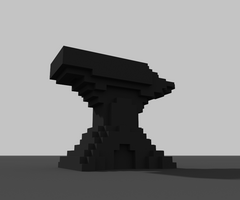Devtober Day #3


Welcome back to Day 3 of Devtober, in which I remember that programming is kinda hard.
Not much in the way of demos or screenshots today, since it's been pretty much all coding for now. I did, however, have to make a snazzy new anvil model (and totally not because I lost the original files for it), so that was a nice distraction from all the coding, at least.
In terms of actual developments, I laid yet more groundwork for systems to come, such as definitions for material types, which then extends into a resource for mutable forging materials, and then finally the actual voxels to hold these materials.
Different materials have their own set of attributes that will affect the crafting process as well as the final product. For example, a material's hardness will determine the maximum sharpness the weapon will be able to hold, and can be increased or decreased through means such as quenching and tempering. This also allows for more complex mechanics such as dynamic alloying, since the final product can simply be an average of the two component material's attributes. Of course, this is a far cry from how actual alloying works in the real world, but it does allow for a lot more player expression in finding the perfect blend of metals. Since I also plan to randomize these material attributes with each save file, finding those "perfect blends" will be a much more personal journey, requiring a fair amount of experimentation in order to master the craft of metallurgy.
Alongside that, I also worked on some of the code for the smithing grid, which will be the actual container for the voxels that make up your worked metal.
Unlike the demo version, the smithing grid will be a physical item that the player can carry around and store in inventories. This will be crucial for mechanics such as storing and reheating worked metal from previous days, as well as allow the grid to be carried physically between workstations for further processing. Since there's a lot of modularity going on in the design here, especially when it comes to supporting the various kinds of metal I'll be implementing, it's especially important that the foundation be stable so few issues occur in the future.
Speaking of voxels, one thing I really struggled with during the initial design for this game was how to allow for the smithing of 3D objects. Since my original prototypes for the smithing mechanic depended on a 2D plane I played around with the idea of allowing smithing grids to be in 3D, but I met a lot of challenges trying to implement it in practice. Then, many months after I finished the demo for the game jam: it hit me. Instead of trying to allow the player to place full-size voxels in 3D, let's instead go smaller and divide each voxel into a collection of subvoxels which can then be removed as needed to create detail. Later on, I'd even like to also expand this mechanic further for things such as being able to engrave specific runic symbols into your weapons to impart special effects.
There are many more mechanics that have yet been little more than words in a .txt file that I've really wanted to make for a while now, but slow and steady wins the race, I suppose. I guess that's the coolest part of taking part in a challenge like this; in watching the days go by, you can also see your progress slowly increase like bricks being stacked in order to make a house.
Very slowly.
Man, I wanna work on those rune mechanics already...
Anyway, that's about it for now. 'Till tomorrow,
- Ian, Lunarium Works
Get Voxelsmith
Voxelsmith
A Blacksmithing Game made in Godot
| Status | In development |
| Author | Lunarium Works |
| Genre | Simulation |
More posts
- Devtober Post-MortemNov 03, 2021
- Devtober Day #23Oct 25, 2021
- Devtober Day #20Oct 21, 2021
- Devtober Day #19Oct 20, 2021
- Devtober Day #18Oct 19, 2021
- Devtober Day #17Oct 18, 2021
- Devtober Day #16Oct 17, 2021
- Devtober Day #15Oct 16, 2021
- Devtober Day #14Oct 15, 2021
- Devtober Day #13Oct 14, 2021
Leave a comment
Log in with itch.io to leave a comment.